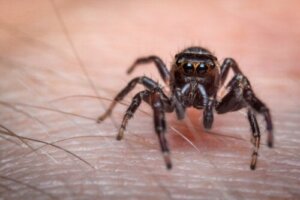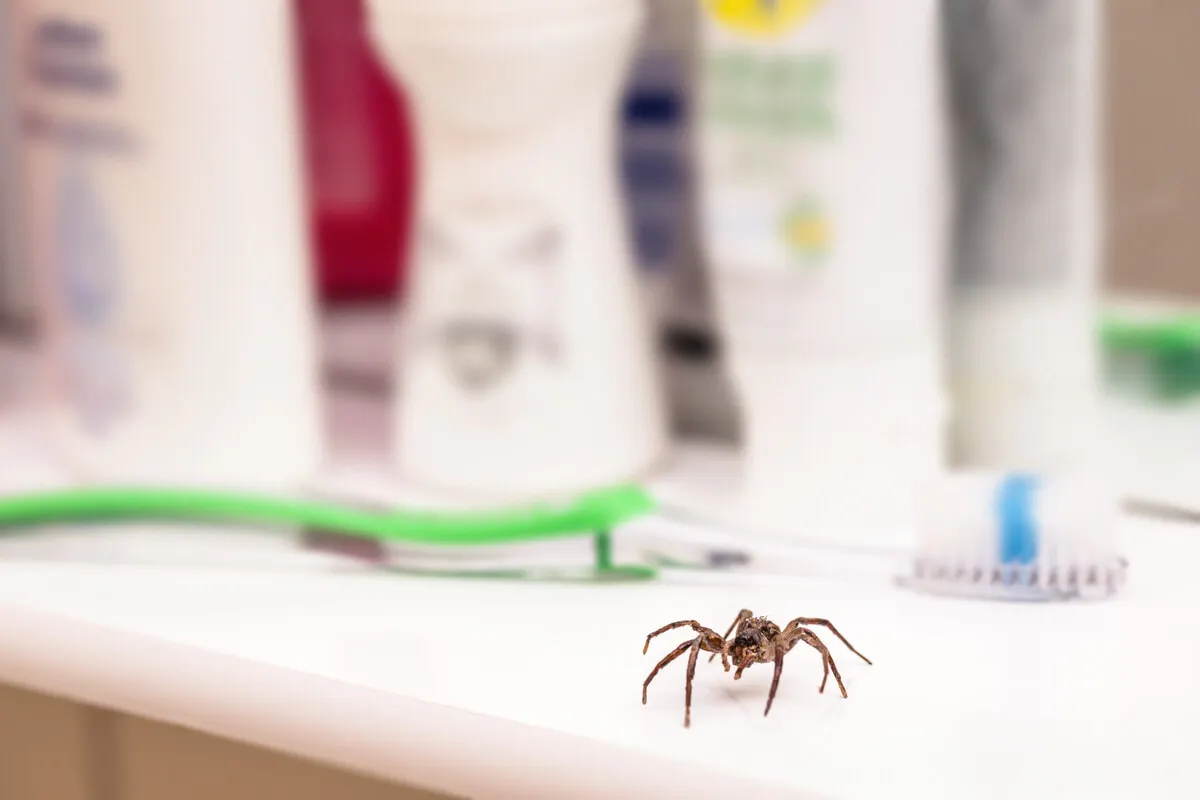Spider Bites: First Aid and When to See a Doctor


Reviewed and approved by the nurse Leidy Mora Molina
Faced with an unexpected attack and spider bites, you may first react with astonishment and pain. Then, we may wonder if it’s dangerous, if we should go to the doctor, or what to do.
It’s important to clarify that not all species of arachnids attack humans; some are even so small that they can’t penetrate the skin. However, others can attack and their bites can be dangerous.
In this article, we’re going to take a look at which arachnids to be concerned about, how to recognize them, the most common symptoms, and what to do in case of a spider bite.
Are spiders poisonous?
Most arachnids are not usually dangerous; they do not even bite or attack. And many are small, so small that their fangs would not have the strength to penetrate human skin.
But when this happens, usually only minor injuries occur. Of course, there are also quite a few reported cases of spider bites that can be serious. It all depends on the species.
Black widow (Latrodectus mactans)
The black widow is found in different parts of the world: North America, Europe, and North Asia. It measures about 4 centimeters and can be easily identified by the red spot on its abdomen.
The incidence of black widow bites is 3-4 cases per 100,000 people. However, mortality is 1%, according to studies.
Brown recluse (Loxosceles reclusa)
Thisis known as a brown spider because of its color. It is distributed throughout most of the Americas and is also identified by a lighter-colored spot on the back. It’s about one inch long and is one of the most dangerous spiders.
Tarantulas (Theraphosidae)
Tarantulas are widespread throughout the world. They don’t have a particular habitat, as they can be found in jungle or desert areas. They usually hide in holes in the ground, in logs, or under rocks.
They can be identified by their large size (almost the size of a human hand), as well as by their hairy texture and protruding fangs. Despite their intimidating appearance, they aren’t usually aggressive.
Similarly, the venom of different tarantula species is not considered dangerous. However, the bite of this spider can be painful and cause allergic reactions in people sensitive to its toxin.
We think you may also enjoy reading this article: How to Get Rid of Indoor Plant Insects Using Vinegar
The Brazilian wandering spider (Phoneutria)
Despite its name, this spider is not limited to a single country, but lives throughout Central and South America. It’s as large as a tarantula, but much faster and more aggressive. It’s considered among the most venomous spiders in the world.
The Hobo spider (Eratigena agrestis)
This is distributed throughout the northern hemisphere, although it prefers somewhat dry climates. It’s considered a dangerous species, not only because the bite of this spider can produce serious reactions, but also because it is found even in domestic environments: window openings, hidden in furniture and household goods in the garage, in closets.
The Camel spider (Solifugae)
They are so named both because of their sandy color and the fact that they are found in desert climates. They are also found in thickets and wooded areas of the Americas, Asia, and Africa.
They are characterized by a pincer on the head and a rather elongated body. They measure between 5 and 8 centimeters, although some can exceed 15 centimeters. Although they are not venomous, their pincers can cause serious wounds.
Wolf spiders (Lycosidae)
This species is found practically all over the world. They can be distinguished by their two large eyes in the middle of their face.
They are usually the size of tarantulas and look similar. They can be found in domestic spaces: in the garden, in the grooves of door and window frames. Their venom isn’t dangerous to humans, although it can produce some allergic reactions.
Jumping spiders (Salticidae)
This is one of the most common house spiders. It’s small (less than 2 centimeters), but its body is robust.
It has light spots on top. It often appears suddenly on houseplants or garden plants. Jumping spider bites are not poisonous, although they do cause reactions if you are allergic.

Symptoms of spider bites
Sometimes you do not notice the spider bite until a while later. However, when this happens and they manage to penetrate the skin and inoculate the toxin, various health complications can result.
Of course, such reactions vary according to the species of arachnid involved. Among the symptoms of spider bites, some common and others not so frequent are the following:
- Redness of the skin with swelling
- Itching or burning with a sensation of heat
- Hives
- Visible wounds with skin tears
- A blister at the puncture site
- Headachea
- Muscle cramps
- A fever with chills
- Drooling (due to the bite of the Brazilian wanderer)
- Purple skin around the bite (brown recluse)
- Oozing from the wound (vagrant)
- Abdominal rigidity, colic, nausea, and vomiting (black widow)
- Accelerated heart rate (tarantula)
- Swollen neck nodes (the wolf spider)
Like this article? You may also like to read: First Aid in Case of Accidental Finger Amputation
First aid in case of a spider bite
When a non-venomous species is detected, several measures can be applied after a spider bite. These include the following:
- Clean and disinfect the area to prevent added bacterial infections.
- Apply ice locally on and around the bite for a few minutes.
- Keep the stung limb elevated to reduce swelling.
- Take an over-the-counter antihistamine, such as diphenhydramine.

Spider bite risks and complications
Spider bite symptoms usually subside over time, even without treatment. At most, some remain for a few days to a week. However, seek medical attention if the discomfort does not go away or becomes more severe.
Your doctor may prescribe some treatment with antibiotics, corticosteroids or pain relievers if there is infection, muscle spasms, or to reduce pain. A booster shot to prevent tetanus is also recommended. This may be required in camel spider bites.
Occasionally, surgery may be performed to remove tissue . One of the possible complications of hobo spider bites is necrosis.
This also occurs with Loxosceles reclusa bites, which cause rapidly progressive necrotic lesions leading to amputation of the affected limb. They can also cause systemic manifestations such as coagulopathies, intravascular hemolysis, and kidney failure.
Bites of some species can cause tissue damage, although very rarely. Deaths are also rare; however, there have been reports of deaths attributed to the Brazilian wandering spider.
When to call emergency services
Call or go to emergency services if the bite was from a suspected dangerous spider (such as the black widow or brown recluse). Similarly, if the person shows any of the following signs:
- Anaphylaxis or anaphylactic shock
- Trouble breathing
- Severe or sharp pain
- An area of swelling that spreads with red lines
When in doubt, it’s always best to have a professional evaluation. Physicians are trained to distinguish one sting from another and apply the corresponding therapeutic approach.
All cited sources were thoroughly reviewed by our team to ensure their quality, reliability, currency, and validity. The bibliography of this article was considered reliable and of academic or scientific accuracy.
- Castro Rodríguez S, Espejo Cárdenas H, Vásquez Villegas G, Espinoza S. Sindrome neurotóxico secundario a mordedura de araña: a propósito de un caso. Voz Andes. 2009; 20: 52-55.
- De Roodt A, Gutiérrez L, Caro R, Lago N, Montenegro J. Obtención de un antiveneno contra el veneno de Phoneutria nigriventer (arachnida; ctenidae). Arch Argent Pediatr. 2011; 109(1): 56-65.
- De Roodt A, Salomón O, Lloveras S, Orduna T. Envenenamiento por arañas del género loxosceles. Medicina (Buenos Aires). 2002; 62: 83-94.
- Espinosa A, Olarte M, Rodríguez C, Roncancio G. Caso sospechoso de envenenamiento por araña reclusa (Loxosceles) y revisión de la literatura. Acta Colombiana de Cuidado Intensivo. 2014; 14 (4): 295-307.
- Haas A, Orduna T, Lloveras S, et al. Guía de prevención, diagnóstico, tratamiento y vigilancia epidemiológica de los envenenamientos por arañas. Buenos Aires: Ministerio de Salud de la Nación/Programa Nacional de Prevención y Control de las Intoxicaciones, 2012.
- Schenone H. Diagnósticos hechos a 1384 pacientes que consultaron por probable mordedura de arañas o picaduras de insectos. Bol. chil. Parasitol. 1996; 51(1/2): 20-7.
- Schenone H. Cuadros tóxicos producidos por mordeduras de araña en Chile: latrodectismo y loxoscelismo. Rev. méd. Chile. 2003; 131(4): 437-444.
- Sotelo-Cruz N, Gómez-Rivera N. Manifestaciones de neurotoxicidad en el envenenamiento por mordedura de araña «viuda negra» en edades pediátricas. Neurología. 2016; 31(4): 215-222.
This text is provided for informational purposes only and does not replace consultation with a professional. If in doubt, consult your specialist.








